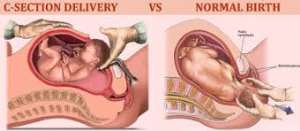
The rising rate of cesarean section has been of concern worldwide. In Ghana, the number of women giving birth via cesarean section is steadily increasing over the past 15 years, with about one out of every five Ghanaian babies born via C-section. While C-sections are sometimes necessary to save lives, many women are opting (Elective C-section) to schedule them when they aren’t medically necessary. The rapidly rising rate of C-sections among low-risk births should be of concern to us. Going through labor and having a vaginal delivery can be a long process that can be physically taxing for the mother. But C-sections come with risks for the mother, including risks from anesthesia, blood loss, infection, a longer recovery period and a higher risk for postpartum depression says a study. In a study conducted in Thailand to compare the differences of maternal (mother) factors and neonatal (newborn) outcomes between mothers who underwent Elective Cesarean Section (ECS) and spontaneous vaginal delivery (SVD). The study concluded that; neonates of ECS mother had weight greater than SVD and had a higher incidence of respiratory distress syndrome (RDS) than the neonate of SVD mother. In addition, neonates of SVD mother had mean Apgar scores greater than the neonates of ECS mother. However, SVD mothers as a result of prolong process of labor had a higher incidence pertaining to presence of meconium stain in amniotic fluid (MSAF) and presence of cord accident as compared to neonate of CS mother.
With regards to respiratory distress syndrome, it is important to note that babies undergo a process during a vaginal birth that readies their lungs, which are filled with fluid in the womb, to breathe oxygen after birth. Howbeit, Babies born via C-section often have respiratory issues with extra fluid in their lungs at birth because they don’t have the chance to undergo this process. Transient tachypnea (abnormal rapid breathing) of the newborn, which is the most common cause of neonatal respiratory distress is more common in babies delivered via C-section. Other risk factors include maternal asthma, male sex, macrosomia (fetal birth weight above 4 grams) and maternal diabetes. In addition, babies born vaginally also receive a dose of good bacteria as they travel through the birth canal which may boost the baby’s immune system and protect the intestinal tract. Some women assume that because their first baby was born via C-section that all of their children will have to be born this way others assume that the scars from the C-section will open with a subsequent pregnancy should they attempt to ‘’push’’.
In fact, the likelihood of the uterus scar splitting open is a very low risk. There’s generally less than a 1 percent chance of that happening on condition that the scar is allowed to heal completely before the next implantation. Hence, all expectant mothers are encouraged to consider and try a vaginal birth after a cesarean section. In the end, the decision around a vaginal birth or a C-section should focus on delivering a healthy baby. Sometimes there are several medical reasons why a delivery doesn’t end up as a vaginal birth to keep either the mother or the baby safe. But to decide on a C-section for a non-medical reason may not be in the best interest of mom or her baby. The unpredictability of labor is the first step in learning about the unpredictability of being a new parent.
By Dr (MH) Ernest Aggrey, 0543999776/[email protected]




 Former Kotoko Player George Asare elected SRC President at PUG Law Faculty
Former Kotoko Player George Asare elected SRC President at PUG Law Faculty
 2024 elections: Consider ‘dumsor’ when casting your votes; NPP deserves less — P...
2024 elections: Consider ‘dumsor’ when casting your votes; NPP deserves less — P...
 You have no grounds to call Mahama incompetent; you’ve failed — Prof. Marfo blas...
You have no grounds to call Mahama incompetent; you’ve failed — Prof. Marfo blas...
 2024 elections: NPP creates better policies for people like us; we’ll vote for B...
2024 elections: NPP creates better policies for people like us; we’ll vote for B...
 Don’t exchange your life for wealth; a sparkle of fire can be your end — Gender ...
Don’t exchange your life for wealth; a sparkle of fire can be your end — Gender ...
 Ghana’s newly installed Poland train reportedly involved in accident while on a ...
Ghana’s newly installed Poland train reportedly involved in accident while on a ...
 Chieftaincy disputes: Government imposes 4pm to 7am curfew on Sampa township
Chieftaincy disputes: Government imposes 4pm to 7am curfew on Sampa township
 Franklin Cudjoe fumes at unaccountable wasteful executive living large at the ex...
Franklin Cudjoe fumes at unaccountable wasteful executive living large at the ex...
 I'll 'stoop too low' for votes; I'm never moved by your propaganda — Oquaye Jnr ...
I'll 'stoop too low' for votes; I'm never moved by your propaganda — Oquaye Jnr ...
 Kumasi Thermal Plant commissioning: I pray God opens the eyes of leaders who don...
Kumasi Thermal Plant commissioning: I pray God opens the eyes of leaders who don...
